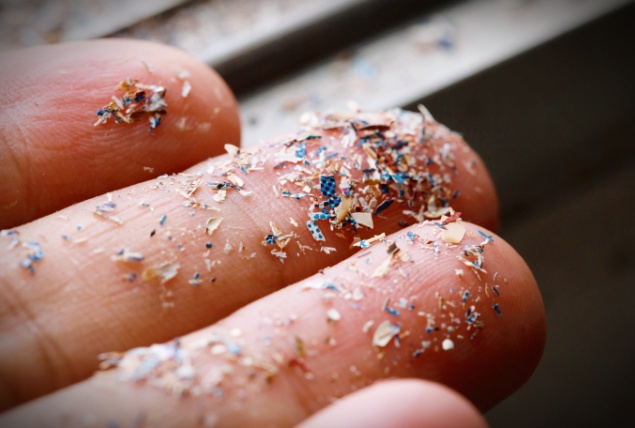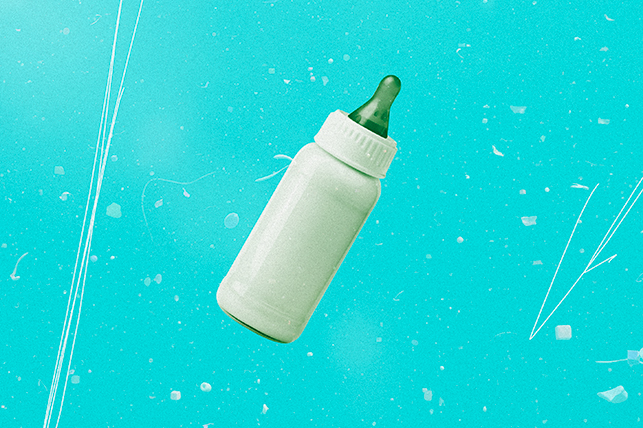Study Finds Microplastics in the Human Testes

Key Points
- Previous research has found small particles of plastic in the human body, including the heart, breast milk, and seminal fluid.
- A new study—larger in scope than its predecessors—found microplastics in all 23 human testicles tested.
- Researchers think plastic pollution may affect sperm production and health, leading to decreased fertility.
Plastic pollution has permeated everything from the world's oceans to the summit of Mount Everest, from the food we eat to the contents of the male ball sack.
Scientists found a concerningly high amount of microplastics in men's testicles in a 2024 report, raising questions about how these particles could affect male reproductive health.
How much microplastic was found in male ball sacks?
Researchers found microplastics in every one of the 23 human testes and 47 dog testes they examined, suggested the 2024 study published in Toxicological Sciences.
On average, human testicles contain roughly 329.44 micrograms of microplastics per gram of tissue, while dog testes contain 122.63 micrograms per gram, according to the study.
Researchers also found the concentration in human testes was significantly higher than that in human placentas.
"At the beginning, I doubted whether microplastics could penetrate the reproductive system," said Xiaozhong "John" Yu, M.D., Ph.D., a professor at the University of New Mexico and lead study author in a news release.
"When I first received the results for dogs, I was surprised. I was even more surprised when I received the results for humans," Yu said.
This is the largest study to measure plastic pollution in the male reproductive system. A team found microplastics in six human testes and 30 semen samples in a smaller 2023 study published in the journal, "Science of the Total Environment."
Yu and his colleagues obtained human testes from the state's medical investigation department, which collects tissue during autopsies and stores it for several years before disposing of it. The canine testicles came from local animal shelters and veterinary practices that perform neutering operations.
The study team quantified the microplastic content by dissolving the fat and proteins and separating the microplastic that remained.
What type of plastics are in men's testes?
Researchers found two types of plastics to be most prevalent in male ball sacks.
Polyethylene (PE) was the most prominent polymer in both men's and dog's testicles, according to the study. It is generally used to make plastic bottles, plastic bags and packaging, among other products.
Scientists aren't sure what effect polyethylene has on human health, but it's known to impact cell behavior, Matthew Campen, Ph.D., a professor at UNM College of Pharmacy and one of the study authors, during an interview with NPR.
Polyvinyl chloride (PVC), which is widely used in plumbing, was the second-most prevalent plastic in dog testes.
Chronic exposure to vinyl chloride can raise the risk of liver damage and cancer, according to The Environmental Protection Agency (EPA).
Why are there microplastics in men's ball sacks?
Previous studies have detected microplastics in various parts of the human body, including placentas, breast milk, semen and our blood supply.
Plastic-containing products shed these small particles, which people can ingest through food, water, air and products such as toothbrushes, indicated a 2024 report.
Why are microplastics especially harmful to men's testicle health?
Animal studies indicate microplastic exposure has potential adverse health effects, including reduced male fertility, suggested a 2022 report.
More research is needed to determine how that translates to human beings, but many scientists believe the effects on men's testicle health to be similar.
Yu and his team compared human and pet dog samples because the two species share biological characteristics and are subject to some of the same environmental factors that affect fertility.
"Compared to rats and other animals, dogs are closer to humans," Yu said. "Physically, their spermatogenesis is closer to humans and the concentration has more similarity to humans."
The researchers couldn't measure the sperm count in human testicles because the testes had been chemically preserved. In the dogs' testes, however, they found higher concentrations of PVC—but not PE—correlated with lower sperm counts.
"The plastic makes a difference. The type of plastic might be correlated with potential function," Yu said. "PVC can release a lot of chemicals that interfere with spermatogenesis and it contains chemicals that cause endocrine disruption."
Microplastics of any kind, upon infiltrating tissues and organs, may impact bodily cells and processes, but some also carry endocrine-disrupting chemicals, which can pose additional problems.
Endocrine disruptors intercept signals between hormones and receptors or mimic hormonal activity, interfering with the body's normal hormonal functions. These interruptions can inhibit egg and sperm production, leading to infertility or subfertility in men and women.
These chemicals—which include bisphenols, flame retardants, perfluoroalkyl and polyfluoroalkyl substances (PFAS), phthalates and heavy metals—can also interrupt other facets of the reproductive system, causing genital malformations and raise the risk of certain cancers, per the Endocrine Society.
Again, more research is needed to investigate how microplastics affect the human male reproductive system. However, if you're wondering how to become more fertile, it's possible that reducing your exposure may help.
"We don't want to scare people," Yu said. "We want to scientifically provide the data and make people aware there are a lot of microplastics. We can make our own choices to better avoid exposure, change our lifestyle and change our behavior."
Could microplastics contribute to erectile dysfunction?
Even if you don't plan to have any (or more) kids, there are plenty of reasons for men to look into how to avoid microplastics—including the fact that these particles may contribute to erectile dysfunction (ED).
Microplastics in human penises demonstrated a correlation between the particles' presence and ED for the first time in the 2024 study in IJIR: Your Sexual Medicine Journal. Here, researchers evaluated tissues from five men undergoing penile implant surgery for erectile dysfunction and found microplastics in four of the men.
Of the seven types of plastics detected, polyethylene terephthalate (PET) and polypropylene (PP) were the most prevalent. Both are widely used in numerous everyday products, including food and drink packaging.
"We need to identify whether microplastics are linked to ED and if there is a level beyond which it causes pathology and what types of microplastics are pathologic," Ranjith Ramasamy, M.D., a reproductive urology expert and the study's lead author, told CNN.
Ramasamy, who based his research on a previous study that found microplastics in the human heart, told CNN his findings didn't surprise him as the penis, like the heart, is a very vascular organ.
"I think we need to be mindful about consuming water and food from plastic bottles and containers and try and limit the use until more research is done to identify levels that could cause pathology," Ramasamy said.
Scientists haven't determined how to remove microplastics from your body, but the University of California, San Francisco offers the following tips on how to avoid microplastics (or at least limit your consumption):
- Avoid microwaving food and drinks in plastic containers
- Buy organic when you can
- Don't put plastic products in the dishwasher
- Limit consumption of animal products as these are more likely than plants to contain contaminants
- Swap plastic bottles for those made of glass or steel
- Use non-toxic cleaners, such as white vinegar and baking soda
The bottom line
Although more research is needed, the findings may help explain the global decline in sperm count and quality. There is evidence suggesting limiting exposure to plastics may benefit genital health.
If you're concerned about the adverse effects of microplastics and endocrine disruptors, visit the EPA website to find more actionable tips to reduce your risk.
Also, speak with your healthcare provider for individualized guidance based on your personal health history and circumstances.




















